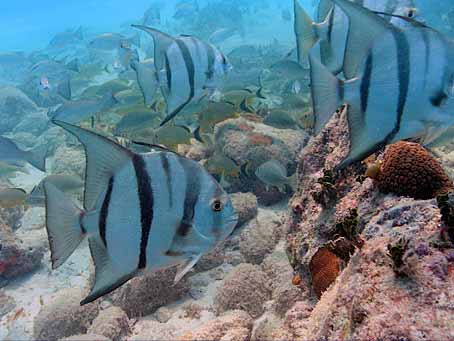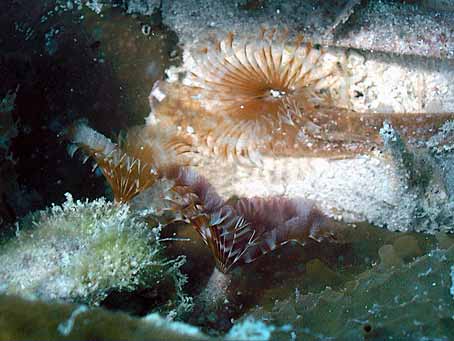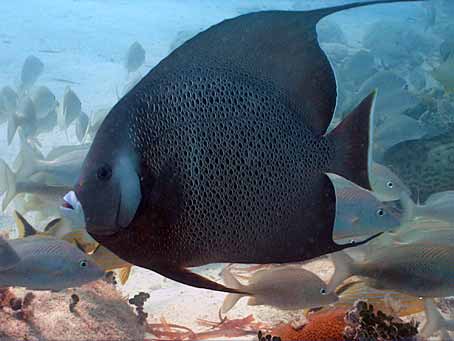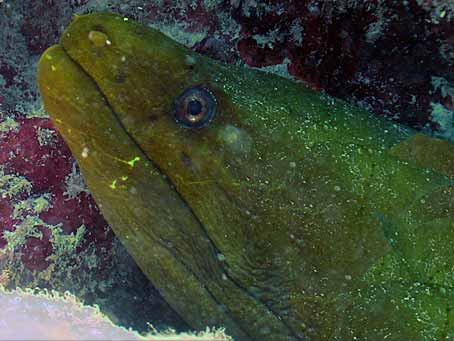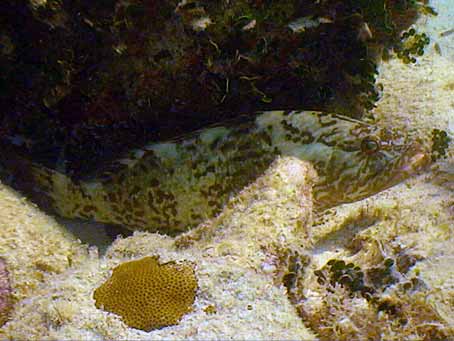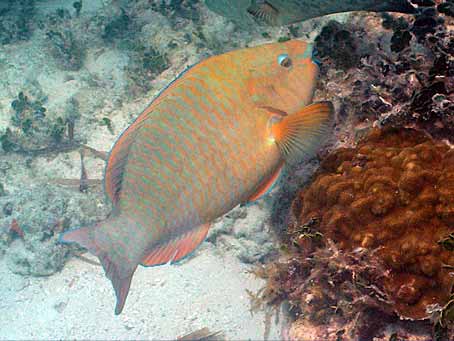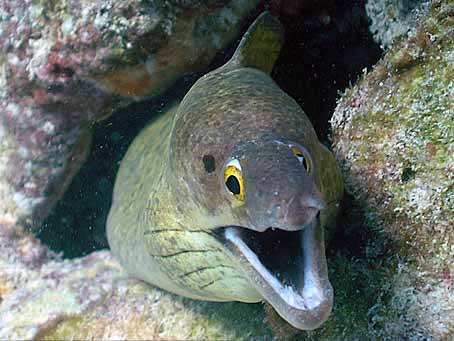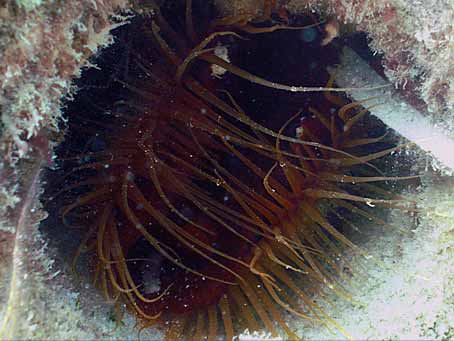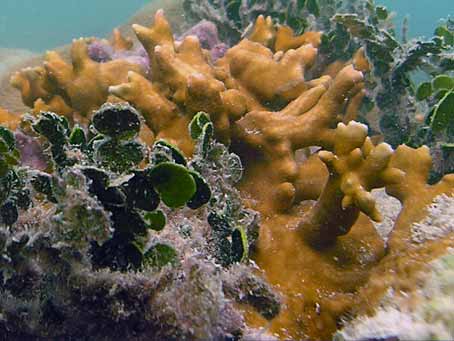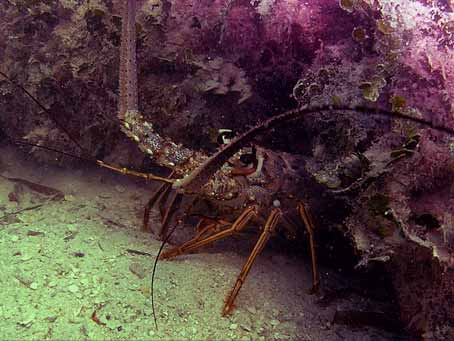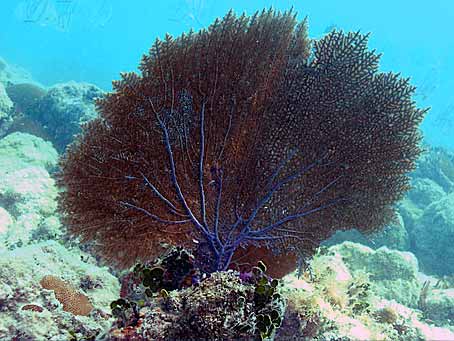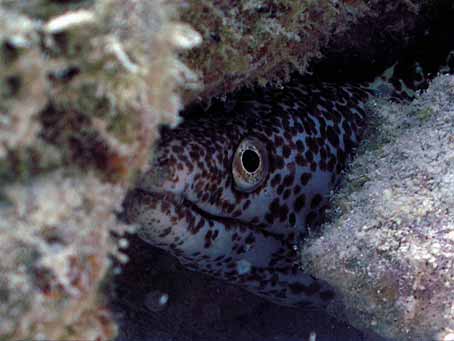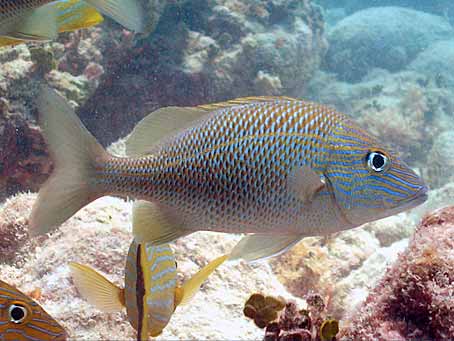This video contains images of the following marine life: Gray Snapper, Purplemouth Moray, Grunts, Arrow Crab, White Grunts, Grouper, Bluestriped Grunts, Atlantic Spadefish, Gray Angelfish, Parrotfish, Porkfish, Sea Fan, Yellow Jacks, Spotted Moray, Rough Fileclam, and Nurse Shark. This video presents a fraction of the diverse marine life that calls San Pedro home.
Anemone – Anemones can come in multiple colors and can be found living in either a colony or alone. The body of an Anemone looks like a bouquet of tentacles with slightly enlarged tips that may be a slightly different color from the body of the tentacle. The Anemone is not considered toxic to the human touch but it may sting a little or irritate the skin if you brush up against it.
bio1.jpg
Anemone
Arrow Crab – The long pointed snout, triangular body, long slender spider-like legs, and golden brown color help distinguish this crab from other crabs. They can often be found under ledges and on coral.
bio2.jpg
Arrow Crab
Atlantic Spadefish – Spadefish get their name because of their spade-shaped body. They are often silver-gray with black fading bars running vertically along their body. These are schooling fish that often circle a SCUBA diver closely.
bio3.jpg
Atlantic Spadefish
Blue Tang – similar to Doctorfish, the Blue Tang can change from blue-ish gray to dark brown as an adult and be bright yellow as a juvenile (pictured here). They will be found on reefs and are often seen head down eating algae.
bio4.jpg
Blue Tang
Bluestriped Grunt – Same as the White Grunt, the common family name, Grunt, comes from the sound the fish make when they grind their teeth together which becomes amplified by their air bladder. Bluestriped Grunts are distinguished by their bright blue stripes running along their body, from lip to tail. Also, their tail and dorsal fin are dark with yellow frosted tips.
bio5.jpg
Bluestriped Grunt
Doctorfish – The Doctor fish will have body bars running perpendicular to the length of the body. The fish often are found with a pale band of color at the base of the tail. They look very similar to Blue Tangs and Ocean Surgeonfish.
bio6.jpg
Doctorfish
Feather Duster – these creatures come in a variety of colors, ranging from brown, to orange, to red, and violet. Many times, Feather Dusters have bands or spots of different colors. They also grow in clusters.
bio7.jpg
Feather Duster
Angelfish – Angelfish come in a variety of colors, from grey and yellow to green, blue, and yellow, to black and yellow, banded, and plain. The Angelfish pictured here is a Gray Angelfish. One identifiable feature of angelfish is the square pectoral fin. Angelfish often swim around the reefs in pairs, so if you see one, look for its mate.
bio8.jpg
Angelfish
Gray Snapper – These fish are often found in small schools, along shallow inshore areas, reefs, under docks, and around shipwrecks. They vary in color from pale gray to dark gray or reddish-brown. Some have a dark band that runs from their lips across the eye.
bio9.jpg
Gray Snapper
Green Moray – The 3 – 5 ft. Moray has a distinct green color throughout its entire body. Unlike many of the other types of eels, the Green Moray does not have any other markings along the body. You can often find Morays hiding during the day inside a hole or poking the heads out of holes. When a Moray is seen opening and closing its mouth, do not worry, it is breathing, not trying to bite you.
bio10.jpg
Green Moray
Grouper – The thick bodies and large, thick lipped frown of the fish help distinguish the grouper. These fish range from a foot to seven feet long, depending on whether or not you are looking at a Red Grouper or a Goliath Grouper. These fish are solitary fish and can often be found lurking around reefs, ledges, and wrecks.
bio11.jpg
Grouper
Nurse Shark – This type of shark generally remains unconcerned with divers in the area. They are often found lying motionless under ledges or in this case under the anchor. Nurse Sharks have a flat-shovel shaped head and a small mouth. They often vary in color from gray to yellow-brown.
bio12.jpg
Nurse Shark
Parrotfish – Parrotfishes are named for their teeth which form a parrot-like beak which scrapes algae from coral and other surfaces. These fish are often very colorful, with their bodies ranging from bright shades of blue, green, red and yellow, to a rainbow of color.
bio13.jpg
Parrotfish
Porkfish – Porkfish are distinguished by their bright yellow-gold striped bodies and two vertical bold black diagonal bands on their head. They can often be found in small groups swimming within a larger school of fish.
bio14.jpg
Porkfish
Purplemouth Moray – These bright-yellow eyed eels have a purple head and a purple, brown, green and yellow spotted body. The moray inhabits shallow reefs, rocky areas, and holes within shipwrecks. They are often found with their heads sticking out of their hole, mouth wide open, but do not fear, they are opening and closing their mouth for respiration.
bio15.jpg
Purplemouth Moray
Rough Fileclam – The brilliant red-orange mantle of the Rough Fileclam can be found in cracks and crevices. Often, the only parts of the fileclam that can be see are the waving tentacles in the current.
bio16.jpg
Rough Fileclam
Fire Coral – The term fire coral is deceptive because this organism is more similar to jellyfish than coral. Swimmers and divers may accidentally contact fire coral having mistaken it for plant material or seaweed. Contact with fire coral can cause a sting or rash not unlike that of the jellyfish.
bio17.jpg
Fire Coral
Flounder – Flounder lie flat on the ocean floor waiting to surprise their prey, usually small fish and shrimp. Flounder are unusual because they have both eyes on one side of their body. Although they are not born with both eyes on the same side of the head, one eye gradually moves to the other side through metamorphosis.
bio18.jpg
Flounder
Caribbean Spiny Lobster – The Caribbean Spiny Lobster can be identified by the shaded areas of brown and tan along the body. The back of the body often has a few dark spots while the abdomen has a few light spots. This type of lobster inhabits the reefs and hides under shipwrecks and other debris in the water.
bio19.jpg
Caribbean Spiny Lobster
Sea Fans – Sea Fan’s grow in colonies which form large fans. Each Fan is composed of a network of branches which are interconnected by a tight mesh which is often purple. Sea Fans can also be yellow and brown.
bio20.jpg
Sea Fans
Spotted Moray – Spotted Moray eels have speckles of dark brown amongst a creamy white. They are often found in shallow reefs, rocky areas, and under shipwreck debris. Eels often open and close their mouths, do not worry, this is not to hurt you, it is an action required for respiration.
bio21.jpg
Spotted Moray
White Grunt – The common family name, Grunt, comes from the sound the fish make when they grind their teeth together which becomes amplified by their air bladder. Most of the fish in the Grunt family are colorful, and drift in schools throughout the shallow reefs during the day and feed at night. The White Grunt is distinguished from other grunts because it has stripes only on its head except one stripe that runs along the length of the fish.
bio22.jpg
White Grunt


